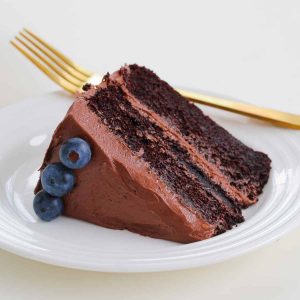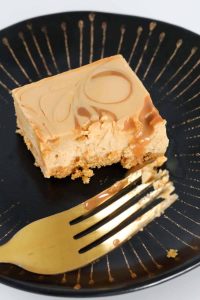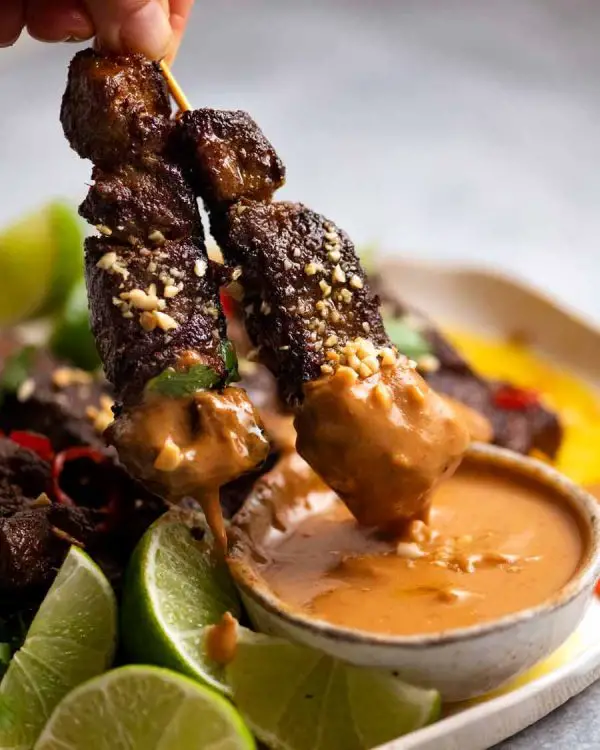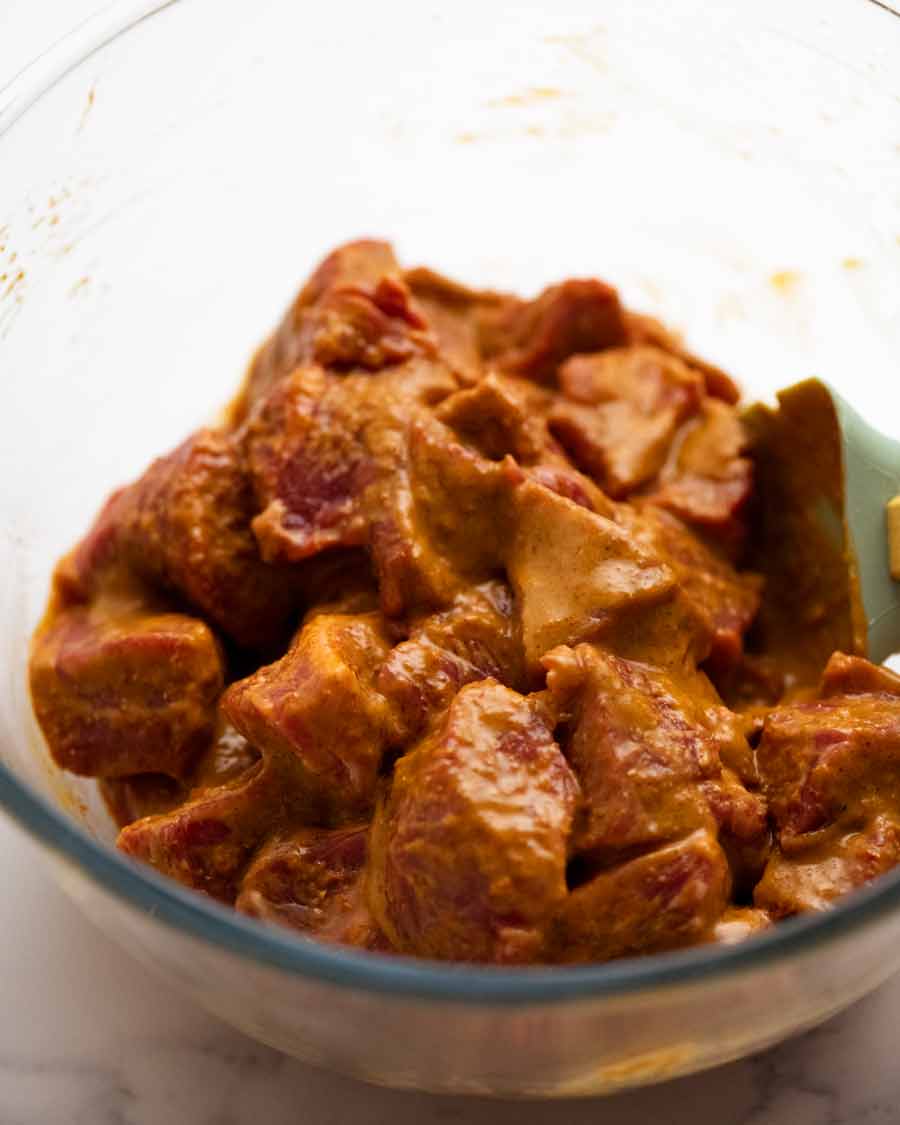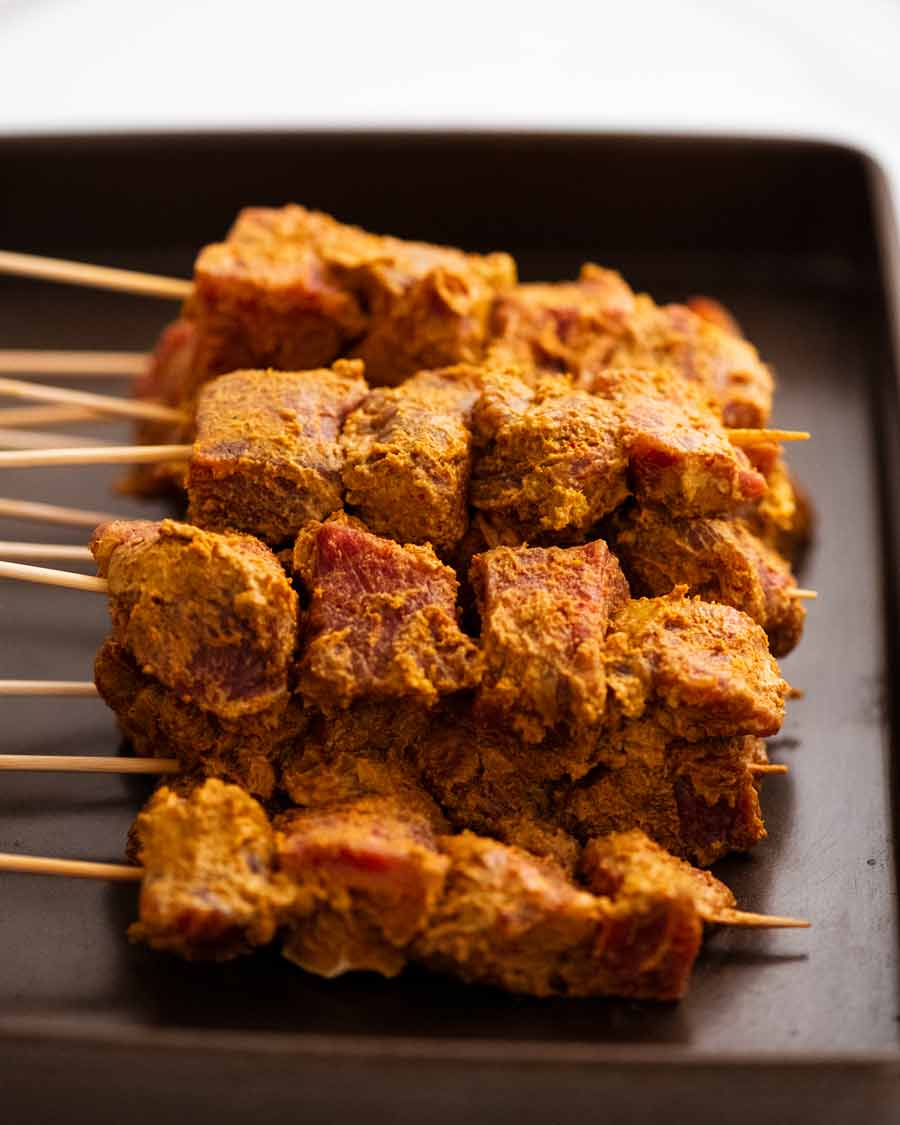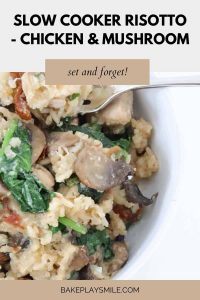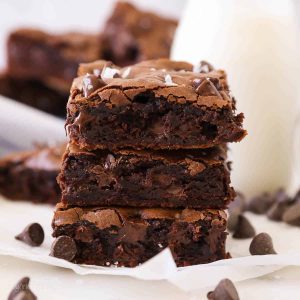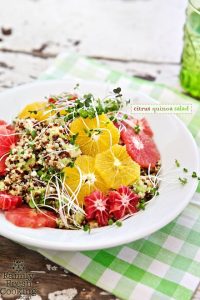This post Beef Satay With Thai Peanut Sauce was last updated on 2022.
Beef Satay is a dish that Thai restaurants can make difficult. You can make this at home for a guaranteed success! You’ll love the secret for how to make economical beef cuts so succulent you’d swear they’re top shelf meat. These skewers taste so good that you could eat them as-is, but they are best served with Thai Peanut Sauce.
Top tip: You can grill these on the barbecue or over charcoal to create a Thai-inspired experience..
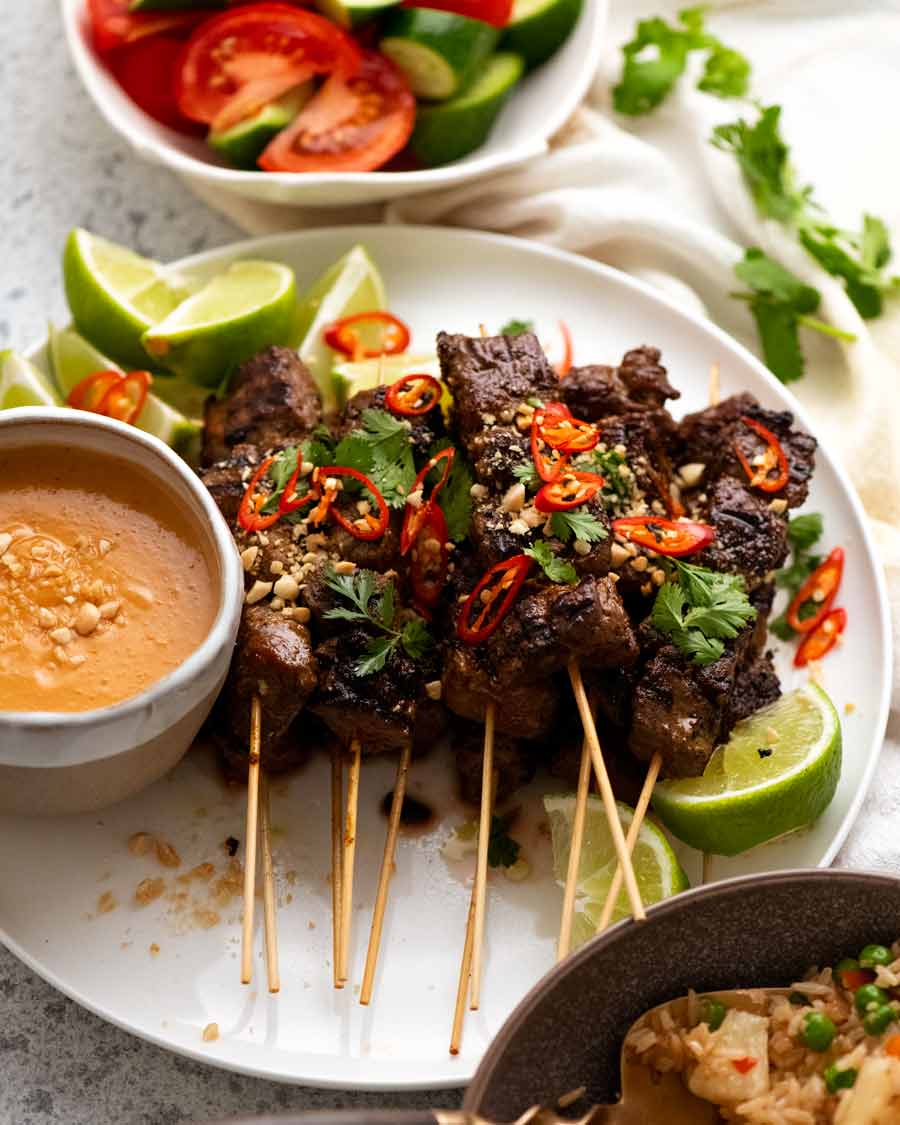
Thai Beef Satay
Because chicken can be difficult to master, I often order Chicken Satay Skewers when I eat at Thai restaurants. Beef Satay on the other side can be extremely hit-or-miss. It is a common refrain to eat dry, bland, and chewy beef.
To experience Beef Satay the way it’s meant to be, better to make it yourself. It’s easy to do, cheaper and you know it will hit the mark!
And what’s that mark? It’s succulent pieces of beef, firstly tickled in a marinade of satay seasoning. Then they’re seared on a ripping hot skillet for charry crust while staying lovely and pink inside. To serve, the skewers are befriended by a bowl of rich and smooth Thai Peanut Sauce – the perfect counterpoint for these smoky sticks of pleasure.
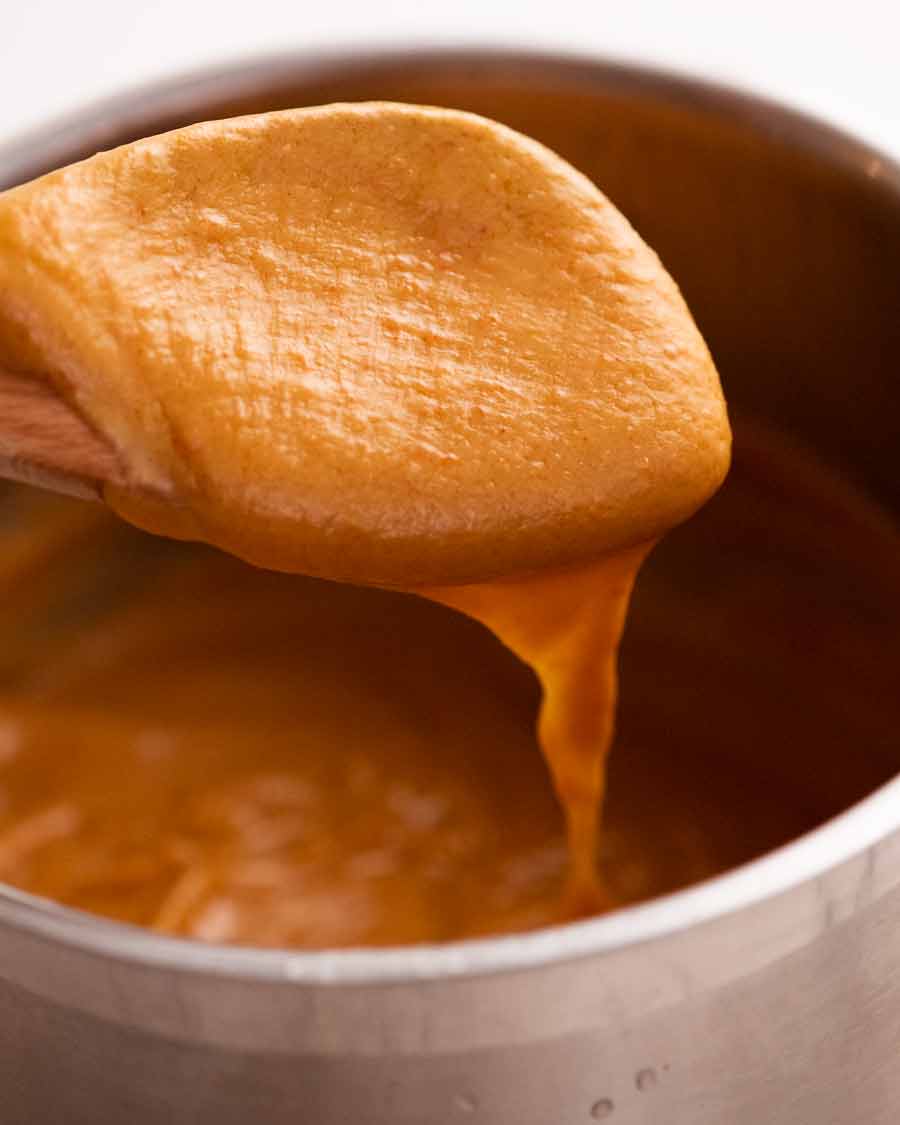
Baking soda/bi-carb is the secret to tenderizing beef
This Beef Satay recipe offers something a little different. It uses a simple method to tenderize a more difficult cut of beef, making it succulent. baking soda / bi-carb. Cubes made from raw beef are marinated in a satay spice with a small amount of baking soda for overnight. Then they are cooked in the normal way.
Baking soda relaxes the meat fibers and makes the beef tenderer without altering its texture. It’s based on a method used by Chinese restaurants called Velvet. Here’s the velveting recipe covering the technique in detail. This Chinese method uses thinner strips of beef and requires a shorter marinating period (40 minutes to an hour). It is important to rinse off the baking soda before you cook. The result is soft, “velvet”-like texture, hence the technique name.
This Thai Beef Satay, however, is a Thai Beef Satay recipe that I want to preserve the original texture of beef. I use less baking soda and marinate for overnight. Too little to be tasted.
The results? Succulent pieces of beef that you’d swear are from a premium cut! The added bonus is that it’s also virtually impossible to overcook baking soda-tenderised beef.
-
Marinating beef for Thai Beef Satay -
Ready to grill Beef Satay skewers
Ingredients for Thai Beef Satay
In this section, I’ve separated the ingredients as follows:
-
Beef Satay marinade
-
Thai Peanut Dipping Sauce
1. Ingredients for Beef Satay Marinde with Tenderiser
Here’s what you need for the beef and satay marinade:
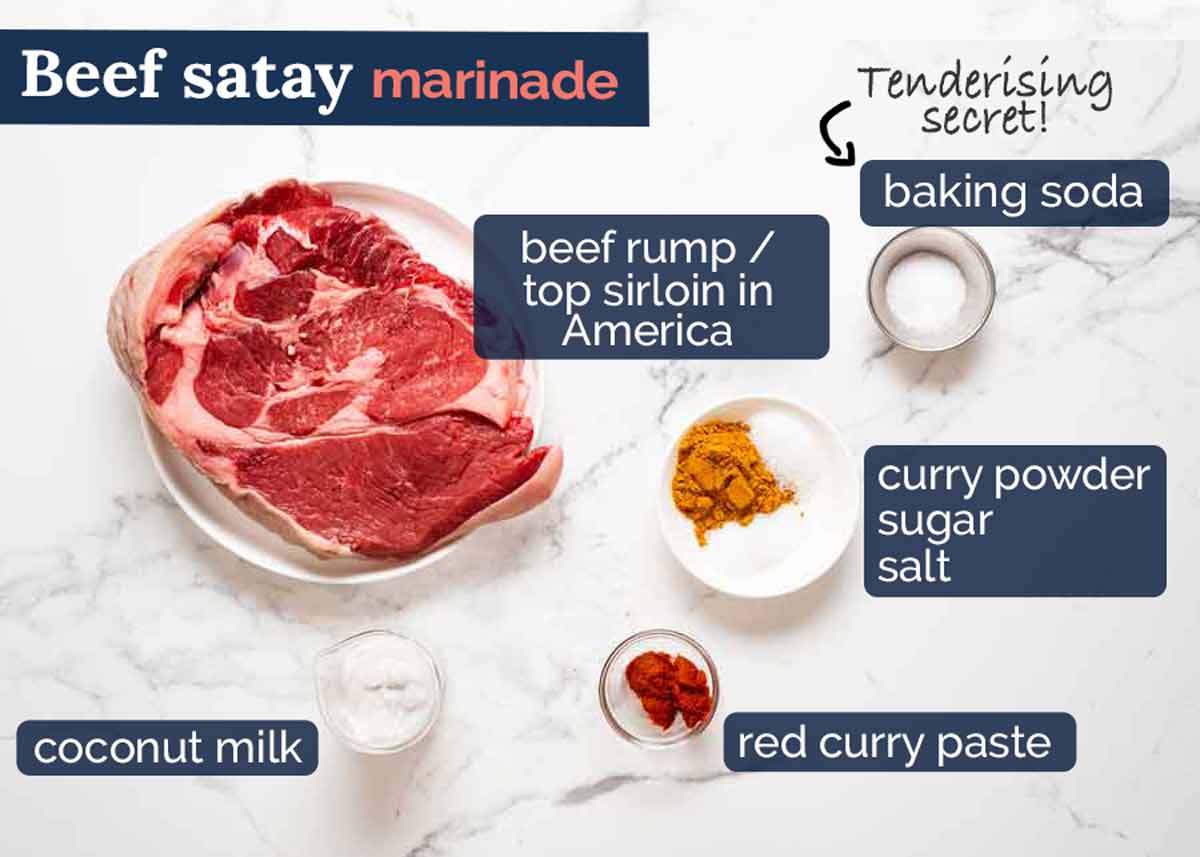
Let’s just give you a brief overview of some of the ingredients.
-
Beef – I like to use rump steak (top sirloin is the equivalent in the US) which I then tenderise using baking soda/bi-carb, as outlined in the above section. This is a good mid-price cut of beef that’s got good beefy flavour and holds its shape will in neat cubes when cooked. This cut of beef can be chewy so marinating it overnight with baking soda is a good idea to tenderize.
Feel free to use a more tender – and more expensive – cut of beef such as scotch fillet / boneless rib eye. If you do, skip the baking soda as obviously there’s no benefit to tenderising the beef further. Be careful not to overcook the beef!
-
Baking soda / bicarb – As explained in the section above, baking soda / bi-carb is the magic ingredient that tenderises tougher cuts of beef in this recipe;
-
Thai red curry paste – This is an essential and key flavouring in Thai satay, for both the beef marinade and in the peanut sauce, because it’s packed with a ton of umami (The food geek term for Savory flavor). Although you could make your curry paste from scratch, this recipe calls for only 3 tablespoons. I prefer to use store-bought curry paste.
Red curry paste: My favoriteMaesri is the brand, as shown below. It is small and very affordable at $1.25. It’s available at large grocery stores here in Australia (Coles, Woolworths, Harris Farms) as well as Asian grocery stores. I find the flavour to be far more delicious than most mainstream curry pastes.
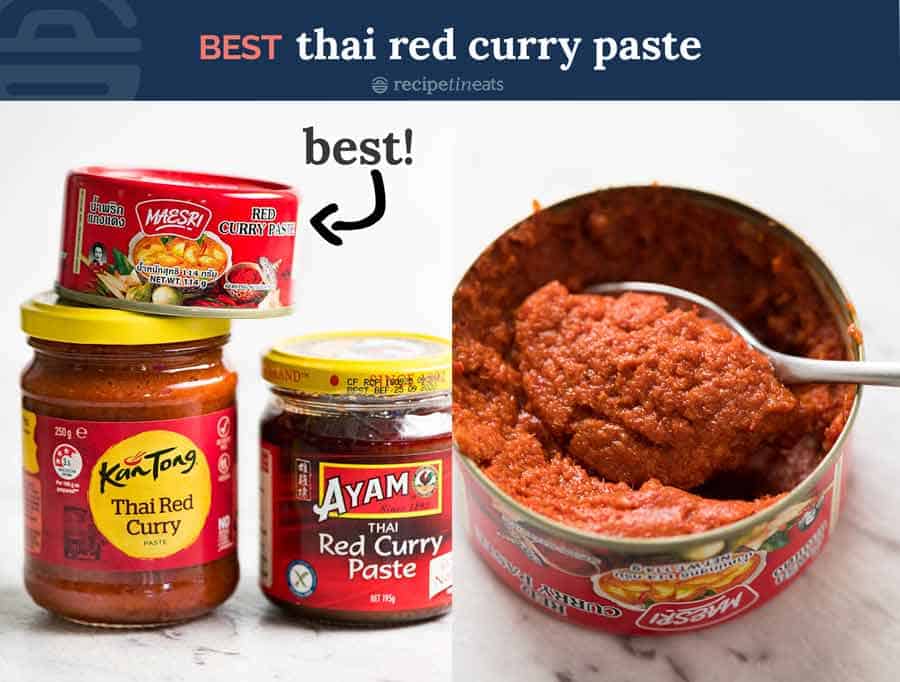
-
Coconut milk – Coconut milk is not all created equal. The cheaper brands contain less actual coconut and therefore are less saturated with water. Ayam brand is 89% coconut kernel extract. Other brands can be as low as 53%! You can use low fat coconut milk, but I won’t condone it! 😂
Leftover coconut milk – The recipe doesn’t use a full can, so freeze leftovers if you don’t have an immediate use for it. Click here to find other recipes that use coconut milk.
-
Curry powder – Another flavor in satay? Curry powder. It’s a background flavour so there’s no need to use a specific type. Any generic “curry powder” is fine here. Clives or Keens is what I use (mild but not hot).
2. Thai Peanut Sauce
And here’s what you need for a restaurant-style Thai Peanut Sauce!
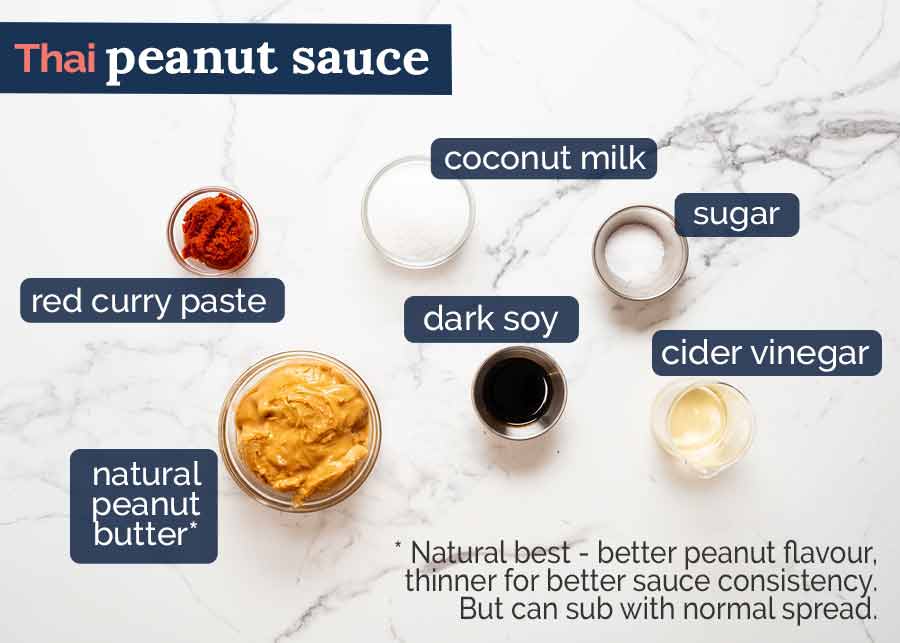
-
Red Curry Paste –This is the most important flavour in Thai Peanut Sauce. I strongly recommend that you get Maesri, which is the recommended brand mentioned in the above section. But if you can’t, any Thai Red Curry Paste you can get will do;
-
Peanut butter – This is the type of peanut butter typically sold in the health food aisle in grocery stores. This peanut butter is not like mass-market products in that it does not contain any added sugar, salt, or other preservatives. It also has a stronger peanut taste and is thinner that sweetened peanut butter (e.g Kraft or Bega). This gives the sauce a better taste and the perfect consistency.
Commercial peanut butter spreads, however, are thicker AndThe peanut flavor is less good. This means that you will need to use more peanut butter in order to get the same taste. The sauce will be thicker than it should be. Commercial peanut butter works well as a substitute.
-
Dark soy sauce – This adds salt and makes the sauce darker. If you don’t have it, light soy sauce or all-purpose soy sauce is fine to use too. It will taste a little less intense.
-
Cider vinegar – There are many options, you just need to add some vinegar to bring out the flavor in the sauce.
-
Coconut milk – The primary liquid in Thai Peanut Sauce. You want good brands with high coconut contents. Ayam is my favorite. And don’t talk to me about low fat coconut milk!
How to make Thai Beef Satay
1. Thai Peanut Sauce
The peanut sauce can be made by blending two ingredients:

-
PlonkAll the ingredients are in a medium saucepan. Heat on medium-low heat.
-
Simmer for 5 minutes, whisking occasionally so the base doesn’t catch.
As I said, it’s a simple “plonk and simmer”!!
2. How to make Thai Beef Satay
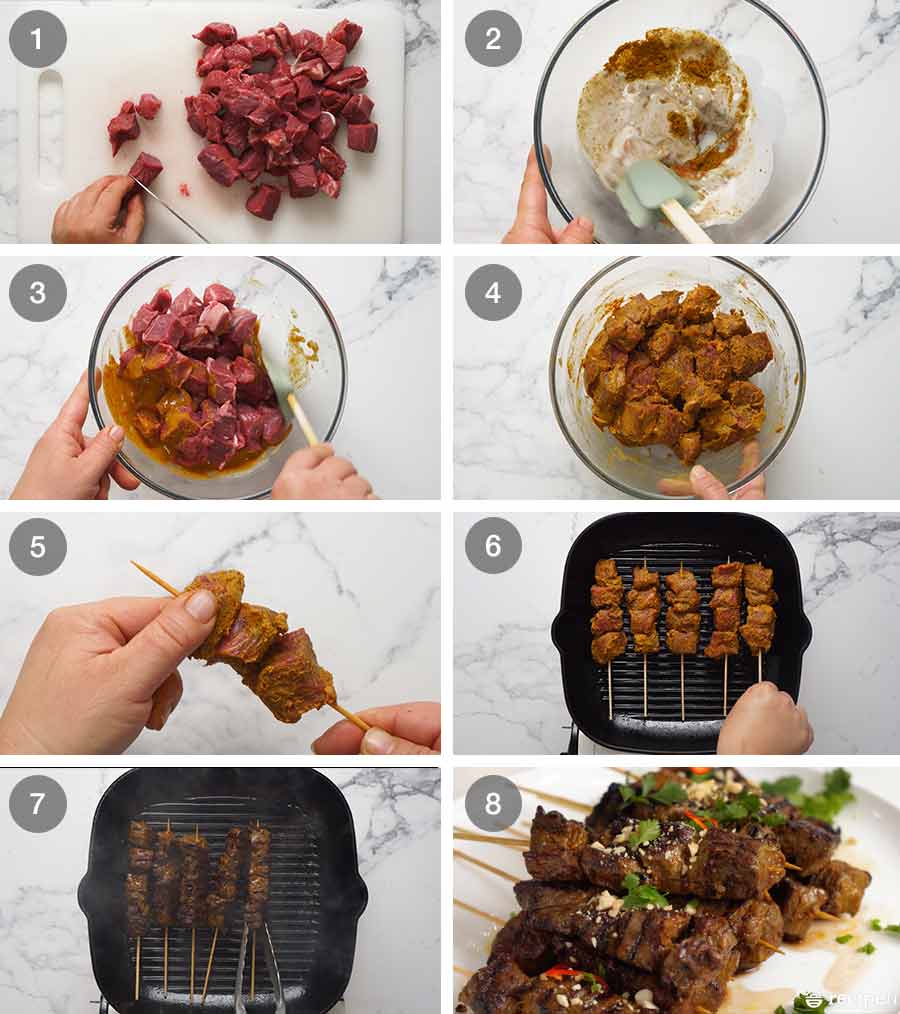
-
Reduce beef into 2.5cm / 1″ cubes.
-
Mix Satay MarinadeIngredients in a bowl
-
Mix beef In the Satay Marinade
-
Marinate beef for 24 Hours. For this recipe, I don’t recommend reducing the marinating time so as to ensure the baking soda has sufficient time to properly tenderise the beef.
-
Thread beefon to skewers. I prefer to use skewers short enough to fit in a skillet. Typically I’ll thread 4 cubes on each skewer, but if I’m serving as an appetiser to pass around then I might only do 3.
-
Cook skewers on the stove in a griddle pan or skillet – or better still, barbecue them – over high heat. To get the best Thai street food experience, you can cook it over charcoal.
-
Turn SkewerCook each side (i.e. all four sides) until they are nicely charred. It takes approximately 8-10 minutes to cook to medium-well done. It’s important to know that beef that’s been tenderised with baking soda only becomes tender once thoroughly cooked. If it’s medium rare, then the beef will be on the chewy side because we’re using an economical cut of beef. Yes This is exactly the opposite of everything you’ve read about how to cook steak.!
An even more amazing fact out beef tenderised using baking soda is that it’s virtually impossible to overcook. Even when it’s cooked perfectly, it will still remain pink in the middle!
-
RestAllow the skewers to rest for 3 minutes before you serve them. To add some colour and visual appeal, garnish with a dusting of finely chopped peanuts, coriander/cilantro and finely sliced red chilli (use large ones so they aren’t spicy).
Of course,, don’t forget the peanut sauce!!
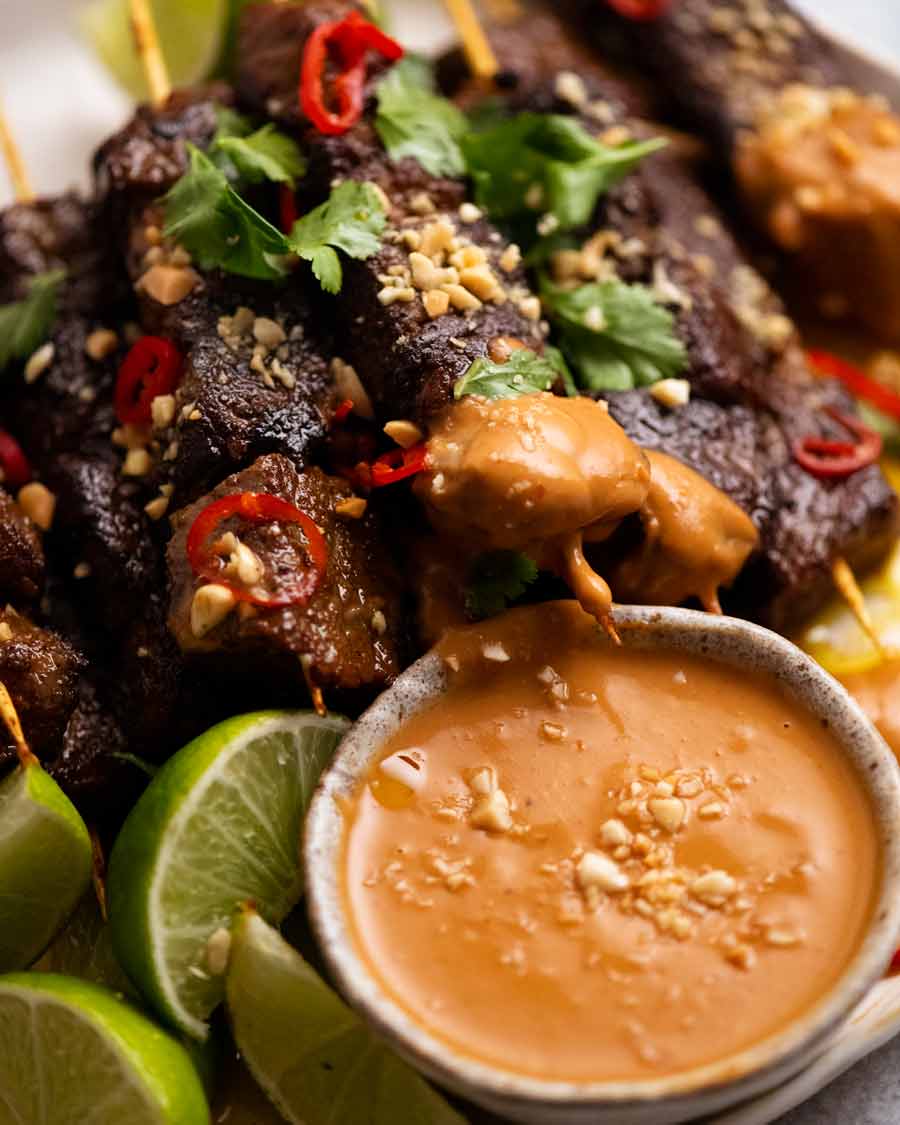
It’s truly impossible to properly capture how tender the beef is in a photo or even in a recipe video!
Notice how pink the beef inside is, even though it has been cooked to medium. That’s the baking soda at work here – the beef stays pink even when cooked beyond medium rare. This happens with tenderised beef such as Korean Beef Galbi.
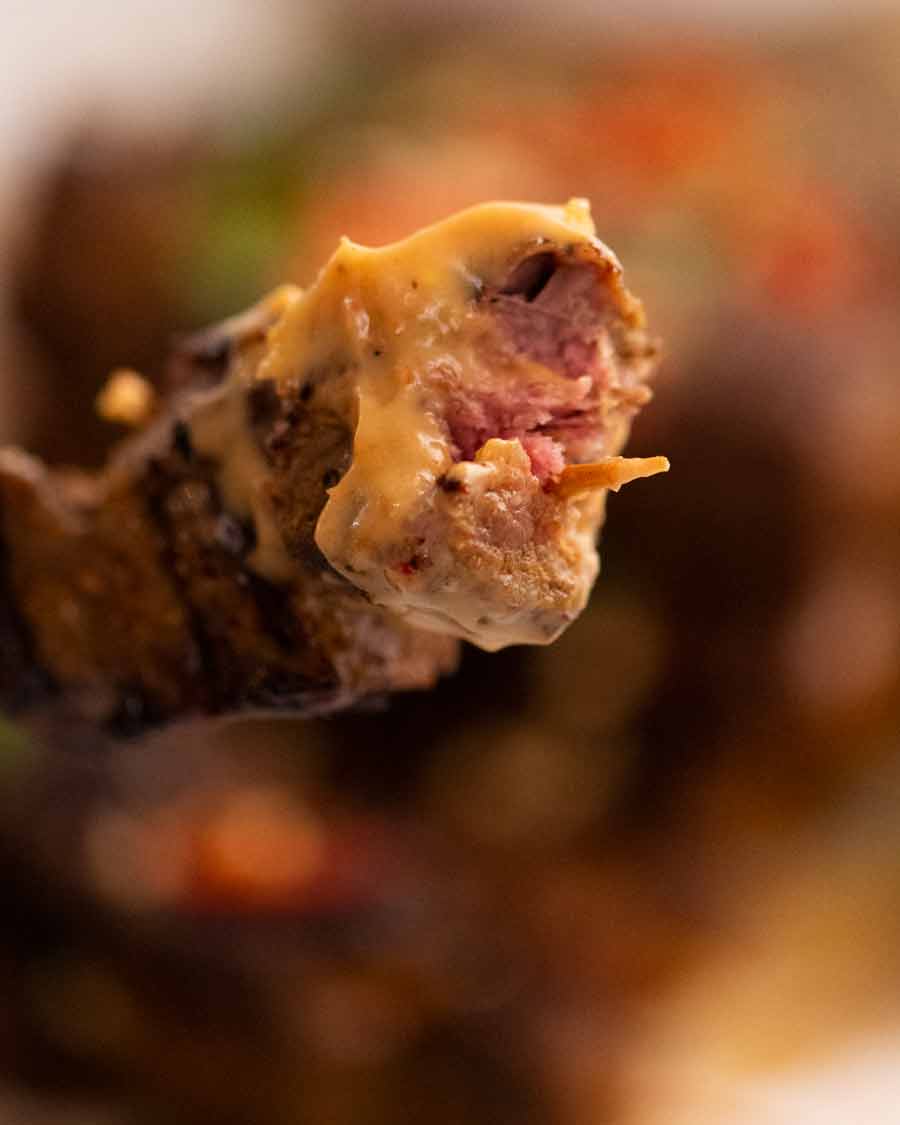
What to serve Thai Beef Saatay?
Thai restaurants often list Beef Satay as a starter. When I make it, however, it is part of a main meal more often than not. Asian BBQ is my favourite menu item when I am with friends!
Here’s a few suggestions for things to serve on the side, or as a starter:
-
Thai Fish Cakes – A popular starter at Thai restaurants, with a Sweet Chilli Dipping Sauce;
-
Thai Lettuce Wraps – The Thai version of Chinese lettuce wraps, with a beautiful lemongrass-flavoured chicken or pork mince filling;
-
Rice options – Jasmine rice is the traditional rice served in Thailand. Plain is fine because you’ll douse it with peanut sauce! Try Thai Fried Rice or Pineapple Fried Rice.
-
Salad options – A cooling Thai Green Papaya Salad is classic! There are other options: Try this Smashed Cucumber Salad, with a Ginger Dressing (my personal favourite!)Asian Slaw; Asian Side Salad. My standard fallback for everything Asian is, of course., possibly Australia’s favourite salad : Chang’s Crispy Noodle Salad (it’s a back-of-the-packet life essential!).
Enjoy! – Nagi x
How to make it
Are you hungry for more?Follow me on Facebook, Pinterest, and Instagram to get the most recent updates. Subscribe to my newsletter

Beef Satay topped with Thai Peanut Sauce
Note: To be tender, baking soda-tenderized beef must be cooked thoroughly. Because we are using inexpensive beef, the beef will still be a little chewy even if it is medium-rare or lower in cooking time.
Top tipGreat to grill on the BBQ. Or even better, use charcoal to create a Thai-inspired experience..
Remaining sauce can be used to make Thai Chicken Satay or Gado Gado (Indonesian Salad w/ Peanut Sauce), or you can just drizzle plain rice with it. You won’t regret it!
Ingredients
- 13-16 bamboo skewers , 16cm/ 6.5″ (Note 1)
Marinade:
- 600g / 1.2lb Beef rump steak (top sirloin) in the US , 2.5 cm/1″ pieces (Note 2)
- 1/4 Cup coconut mik , full fat (I use Ayam, Note 3)
- 1 tbsp curry powder (Note 4)
- 1 tsp white sugar
- 2 tsp Red curry paste (Note 5)
- 1/2 tsp baking soda / bi-carb (tenderiser, Note 6)
- 1 tsp Salt
Thai Peanut Sauce
- 1 tbsp Red curry paste (Note 5)
- 2/3 Cup coconut milk , full fat (I use Ayam, Note 3)
- 1/3 Cup Peanut butter Smooth (Note 7).
- 1 1/2 tbsp White sugar
- 1 tsp dark soy sauce (Note 8)
- 1/2 tsp Salt
- 1 tbsp cider vinegar (Note 9)
- 1/3 Cup Water
Cooking & Serving:
- 1 1/2 tbsp Vegetable oil For cooking
- 2 tbsp peanuts Finely chopped
- Lime wedges (optional)
- Coriander/cilantro leaves and sliced red chili (optional)
Instructions
-
To prevent them from burning, soak the skewers in water for two hours before cooking over charcoal or on a barbecue.
Thai Beef Satay Skewers
-
In a bowl, combine the marinade and beef. Marinate overnight in a bowl. Cover the container with cling wrap.
-
Thread onto skewers – I do 4 pieces each.
-
1.25 tbsp oil in large nonstick pan on medium-high heat.
-
Cook for 10 minutes): To cook the skewers, heat a few at a time until all sides are golden. This should take between 2 and 2 1/2 minutes. To be tender, the baking soda-tenderized beef must be cooked thoroughly. If the cooking time is medium, or less, the beef will still be a little chewy.
-
Rest: Place skewers on a plate, and let them rest for three minutes before you serve with Peanut Sauce.
Thai Peanut Sauce
-
All peanut sauce ingredients into a small saucepan. Heat on medium-low heat.
-
Mix everything together, then simmer, stirring every so often, for five minutes. Adjust consistency with water – it should be a pourable but thickish sauce.
-
Take skewers out of the oven and cover them with a lid.
Serving:
-
Put sauce in a bowl. Sprinkle with some peanuts – stir some through if you want.
-
Spread the satay pieces on a plate and garnish with coriander, chilli, and remaining peanuts.
-
Serve the dish with sauce to dip. To complete the meal, add a side of Jasmine Rice, Thai Fried Rice, or Pineapple Fried Rice.
Recipe Notes
2. Beef – I use rump steak (top sirloin in the US) which is a mid range economical cut with good beefy flavour that can sometimes be a bit chewy. However, the baking soda/bi carb in the marinade tenderises it – a Thai cooking secret!
If you use a well-marbled, more premium steak cut, such as a good quality scotch fillet (boneless rib eye), then there’s no need to use the baking soda. Be careful not to overcook the beef when you cook the skewers.
In theory, this recipe will work for pork as well (including tenderising) but I haven’t experimented with different cuts. For chicken, see Thai Chicken Satay.
3. Coconut milk – Not all coconut milk is created equal. The coconut flavour is less prominent in cheaper brands, which are often diluted with water. Ayam is 89%. Some brands may be as low as 53%). Low fat? I do not accept any responsibility for your use of it.
Leftover coconut milk – freeze it. Find a recipe using leftovers by typing “coconut milk” in the search bar on my website, then hit “Using this ingredient”.
4. Curry powder – any is fine here because it’s a background flavour. I use Clives (mild, but not hot) and Keens.
5. Red curry paste – The best Thai red curry paste (in my opinion) is Maesri which comes in small cans and also happens to be the cheapest. Available at Asian shops, large supermarkets (Coles Woolies, Harris), and major supermarkets (Coles Woolies, Woolies, Harris). But any brand will do because it’s an enhancer rather than key flavouring.
If using homemade Thai red curry paste, double the curry paste, add 1 tsp fish sauce + 1 tsp sugar into the beef marinade, and 2 tsp fish sauce + 2 tsp sugar into Peanut Sauce (homemade doesn’t have the seasonings jar paste does).
6. Baking soda / bi-carb – This tenderizes the beef, making it succulent. It is based on an old Chinese restaurant technique. Velvet beef. More information is available in the post
7. Peanut butterThis peanut butter is made entirely from peanuts. It has a stronger peanut taste than conventional peanut butter that contains sugar or other additives. Because it is thinner, less water is needed to obtain the desired consistency. It is readily available in supermarkets’ health food sections.
Peanut butter spread can be used, but the flavour will not be as intense and the sauce may be thicker. Do not be tempted to dilute with too much water – it will dilute the flavour.
One cup of unsalted peanuts should be submerged in 1/2 cup coconut milk. It will help make it super smooth.
8. Dark soy sauceSeasons and intensifies the colour of sauce. Substitute light or all-purpose soy sauce, but the sauce colour will remain lighter.
9. Cider vinegarPlain white vinegar can be substituted. It is possible to substitute with lime juice, rice vinegar or other clear wines. However, they may not be 100% authentic.
10. Peanut Sauce – makes a bit more than you need. Lasts 1 week in the fridge – or freeze. Use leftover for:
- Thai Chicken Satay
- Gado Gado (Indonesian Salad with peanut sauce)
- Sauce for rice, noodles and veggies (raw, steamed).
- Dip for prawn crackers, and vegetables
- As the dressing for this Chinese Chicken Salad, Satay Noodle Salad, Peanut Noodle Salad or Sesame Noodles
10. NutritionAssume that peanut sauce has been consumed.
Nutrition Information:
Dozer Life
My iPhone likes to offer “Moments” such as “One year ago today”. This is what it displayed to me:
-
I was able to pick Dozer up from the border last year!
It also showed me this 😖:

Here’s another:

Three photos that capture the essence of this day from last year.





